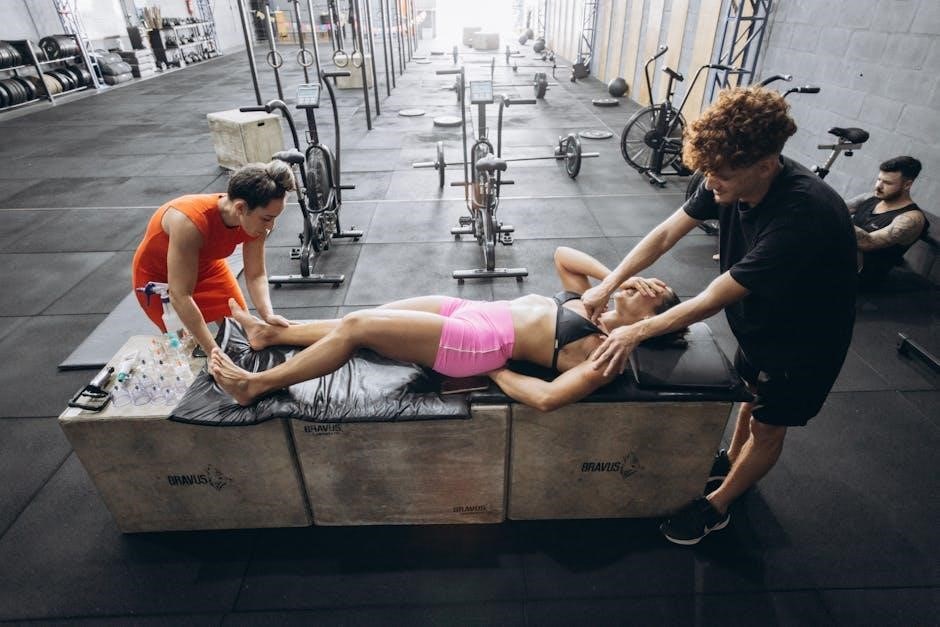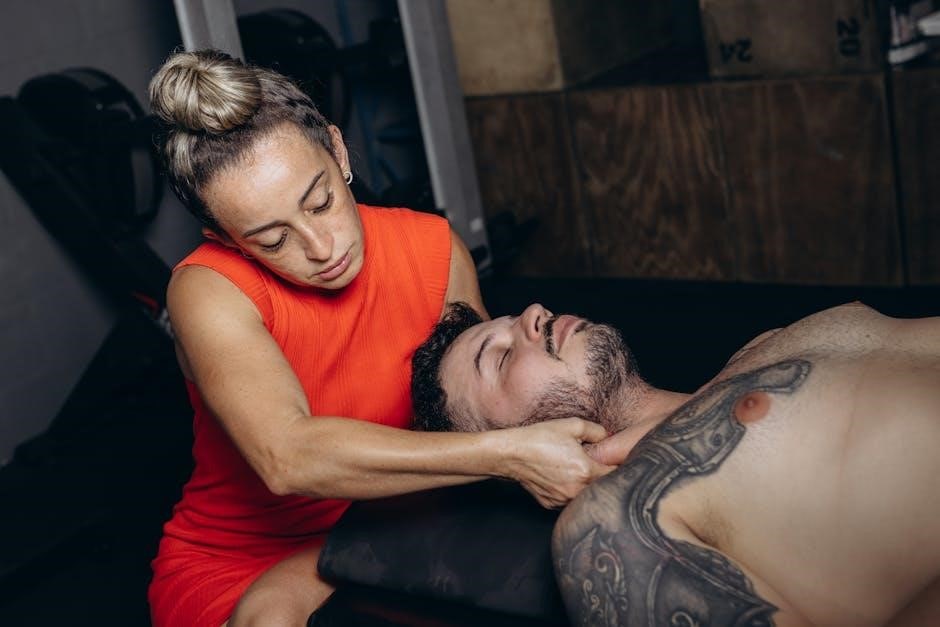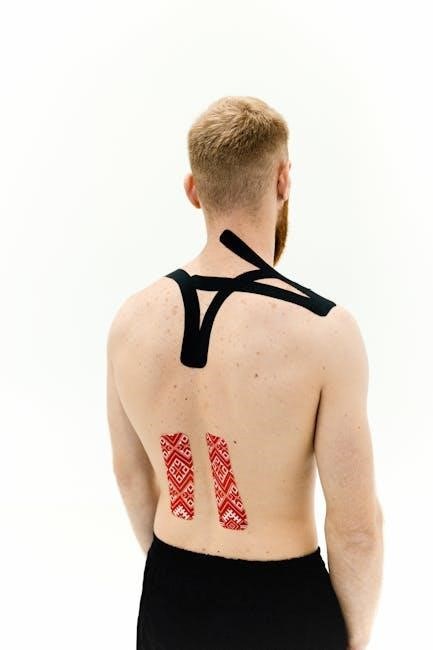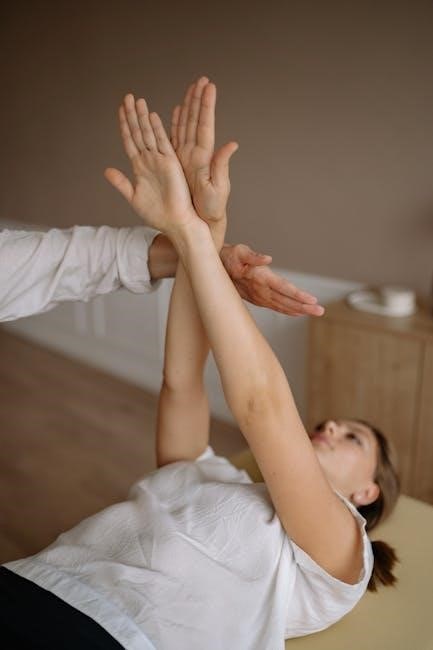A well-structured femur fracture physical therapy protocol is essential for optimal recovery, addressing factors like fracture type, surgery, patient age, health, and personal goals to restore function and mobility.
1.1 Overview of Femur Fractures and Rehabilitation Importance
Femur fractures are common injuries, particularly in the elderly, requiring prompt treatment to restore mobility and prevent complications. Rehabilitation plays a critical role in improving quality of life, addressing pain, and ensuring proper healing. A structured protocol is essential to guide safe and effective recovery, tailored to fracture type and patient needs.
1.2 Purpose of a Structured Physical Therapy Protocol
A structured protocol ensures standardized care, promoting consistent outcomes, reducing complications, and enhancing patient safety. It guides therapists in addressing pain, restoring mobility, and strengthening muscles, while considering individual patient factors to achieve optimal recovery and return to functional activities efficiently.

Anatomy and Classification of Femur Fractures
The femur, or thigh bone, is divided into the proximal (hip), shaft, and distal (knee) regions. Fractures are classified by location, type, and severity, guiding treatment and rehabilitation strategies.
2.1 Proximal Femur Fractures (Hip Fractures)
Proximal femur fractures occur near the hip joint, often in elderly patients. Treatment typically involves surgical fixation or replacement, with early rehabilitation focusing on pain management, mobility, and preventing complications like deep vein thrombosis. These fractures significantly impact functional independence, necessitating tailored physical therapy interventions.
2.2 Femoral Shaft Fractures
Femoral shaft fractures occur in the long, cylindrical part of the femur, often due to high-energy trauma. Treatment typically involves intramedullary nailing, allowing early mobilization. Rehabilitation focuses on progressive weight-bearing, strength, and range of motion exercises to restore function and mobility in this critical load-bearing bone.
2.3 Distal Femur Fractures
Distal femur fractures occur near the knee joint, often affecting weight-bearing and knee function. Surgical intervention, such as internal fixation, is common. Rehabilitation emphasizes early knee mobility, strength training, and weight-bearing progression to restore functional activities and prevent stiffness or deformity in the lower extremity.

Immediate Post-Surgical Phase (0-2 Weeks)
Focuses on pain and swelling reduction, limited weight-bearing, and early mobilization to prevent complications and promote healing in the initial two weeks post-surgery.
3.1 Pain Management and Edema Control
Pain is managed using a multimodal approach, including pharmacological agents like Lovenox for swelling and pain relief. Ice therapy and elevation reduce edema, while monitoring ensures proper healing. Patient education emphasizes adherence to pain protocols and safety measures to prevent complications during the early recovery phase.
3.2 Initial Weight-Bearing Status and Mobility
Initial weight-bearing status is typically non-weight-bearing or touch-down weight-bearing, depending on fracture type and surgical intervention. Mobility is facilitated with assistive devices like crutches or walkers to avoid putting stress on the femur. Early ambulation focuses on safety, proper gait mechanics, and adherence to weight-bearing restrictions to prevent complications and promote healing.
3;4 Early Range of Motion Exercises
Early range of motion exercises focus on gentle, pain-free movements to maintain joint mobility and prevent stiffness. Ankle pumps, heel slides, and knee mobilization are commonly used. These exercises are performed within a pain-free range and supervised by a therapist to promote healing and restore flexibility without stressing the fracture site.

Early Protective Phase (2-6 Weeks)
This phase focuses on gradual weight-bearing progression, isometric strengthening, and joint mobilization to enhance stability and mobility while protecting the healing fracture.
4.1 Progressive Weight Bearing and Gait Training

Progressive weight-bearing and gait training involve advancing from non-weight-bearing to partial and full weight-bearing, using assistive devices like crutches or walkers. This phase emphasizes proper gait mechanics, balance, and strength to ensure safe ambulation and prevent complications, tailored to the patient’s healing progress and surgical instructions.
4.2 Isometric Strengthening Exercises
Isometric exercises, such as quadriceps sets, gluteal squeezes, and hamstring exercises, are essential in the early stages of femur fracture rehabilitation. These exercises enhance muscle strength without joint movement, reducing fracture site stress. Patients perform 3 sets of 10 repetitions daily, focusing on proper breathing to avoid muscle fatigue and promote circulation.
4.3 Knee and Hip Joint Mobilization
Knee and hip joint mobilization techniques are introduced to restore flexibility and range of motion. Gentle stretching and passive exercises target tight muscles and joints, improving circulation and reducing stiffness. These exercises are performed 3-5 times daily, focusing on controlled movements to avoid discomfort while enhancing joint stability and overall mobility.

Intermediate Rehabilitation Phase (6-12 Weeks)
This phase focuses on advancing strength, balance, and functional activities. Patients progress to weight-bearing exercises, proprioception training, and daily living tasks to enhance independence and prepare for higher-level movements.
5.1 Advanced Strengthening Exercises
During this phase, patients transition to advanced exercises, such as weight-bearing squats, lunges, and step-ups, to enhance lower limb strength and stability. Core strengthening is emphasized to improve overall stability and posture, while functional movements are integrated to prepare for daily activities and more complex tasks.
5.2 Proprioception and Balance Training
Proprioception and balance exercises, such as single-leg stands, BOSU ball training, and wobble board activities, are introduced to enhance joint stability and sensory awareness. These exercises improve coordination and reduce the risk of falls, helping patients regain confidence in their mobility and functional abilities during the intermediate phase of rehabilitation.
5.3 Functional Activities and ADL Training
Functional activities and ADL training focus on restoring practical skills like transfers, stair navigation, and household tasks. Patients learn to safely perform daily activities using adaptive equipment. These exercises promote independence, reduce reliance on assistive devices, and enhance overall quality of life during the intermediate rehabilitation phase.
Advanced Strengthening and Return to Function Phase (3-6 Months)
This phase emphasizes high-intensity exercises to restore strength, agility, and functional movements. Patients progress to sports-specific training and activities, focusing on gait normalization and full integration into daily life or athletic pursuits.
6.1 High-Load Strengthening Exercises
High-load exercises, such as weighted squats, lunges, and leg presses, are introduced to enhance muscle strength and endurance. Progressive resistance using bands or weights is applied to improve functional capacity. These exercises target the quadriceps, hamstrings, and glutes, preparing the patient for return to daily activities or sports, tailored to their recovery stage.
6.2 Agility and Sports-Specific Training
Agility drills, such as cone weaving and shuttle runs, enhance speed, coordination, and balance. Sports-specific exercises mimic movements from the patient’s sport, like soccer or basketball, to prepare for return to play. Progression includes dynamic pivots and reaction training, ensuring the femur can withstand high-demand activities while maintaining proper biomechanics and reducing re-injury risk.
6.3 Final Gait and Mobility Assessment
The final assessment evaluates gait mechanics, weight distribution, and overall mobility to ensure symmetry and efficiency. Objective measures include gait speed, stride length, and joint range of motion. Any residual deficits are addressed to optimize functional independence and prepare the patient for unrestricted activities, ensuring a safe and effective return to pre-injury levels.
Rehabilitation Exercises for Femur Fractures
Rehabilitation exercises focus on restoring strength, mobility, and function. They include range of motion, strengthening, and balance activities tailored to promote healing and return to normal activities.
7.1 Range of Motion (ROM) Exercises
Range of motion exercises are crucial for maintaining joint mobility and preventing stiffness. Patients perform activities like ankle pumps, knee flexion, and hip abduction to restore movement and flexibility, promoting healing and functional recovery after a femur fracture.
7.2 Strengthening Exercises for the Quadriceps and Hamstrings
Strengthening exercises target the quadriceps and hamstrings to restore muscle function and support the femur. Techniques include isometric exercises, straight leg raises, and progressive resistance using bands or weights, enhancing stability and facilitating return to normal activities and mobility post-fracture.
7.3 Core Strengthening and Stability Exercises
Core exercises improve stability and balance, essential for femur fracture recovery. Techniques include planks, bridges, and pelvic tilts, enhancing trunk strength and proprioception. These exercises support proper posture, reduce complications, and promote efficient gait mechanics, aiding in overall functional recovery and preventing future injuries.

Gait Training and Ambulation
Gait training focuses on restoring normal walking patterns using assistive devices and progressive weight-bearing techniques, ensuring safe mobility and preventing complications during femur fracture recovery.
8.1 Use of Assistive Devices (Crutches, Walker)
Assistive devices like crutches or walkers are crucial for mobility post-femur fracture. They reduce weight-bearing stress, prevent complications, and enhance stability during gait training. Patients often transition from a walker to crutches as strength improves, ensuring safe ambulation and adherence to weight-bearing restrictions.
8.2 Weight-Bearing Progression Techniques
Weight-bearing progression is tailored to the fracture’s healing timeline and surgical recommendations. It begins with non-weight-bearing or partial weight-bearing, advancing to full weight-bearing as strength and bone integrity improve. Techniques are adjusted to avoid overloading the fracture site, ensuring proper alignment and promoting optimal mobility and strength during the rehabilitation process.
8.3 Stair Navigation and Community Ambulation
Stair navigation and community ambulation training focus on improving functional mobility in real-world settings. Patients learn safe techniques for ascending and descending stairs, using assistive devices as needed. Emphasis is placed on balance, coordination, and confidence to navigate various environments, preparing for independent living and reducing fall risks during community activities.

Pain Management and Multimodal Approach
Pain management incorporates pharmacological and non-pharmacological strategies, such as analgesics, ice therapy, and TENS, to optimize comfort and facilitate rehabilitation progress. A multimodal approach ensures comprehensive care.
9.1 Pharmacological Pain Relief Options
Pharmacological pain relief includes analgesics like acetaminophen and NSAIDs for mild to moderate pain, while opioids are reserved for severe cases. Muscle relaxants may be prescribed for spasms, and anti-inflammatory drugs reduce swelling, enhancing patient comfort during the healing process.
9.2 Non-Pharmacological Pain Management Techniques
Non-pharmacological methods include ice therapy, soft tissue mobilization, and manual lymphatic drainage to reduce swelling and discomfort. Magnetic therapy and gentle exercises like ankle pumps also promote circulation and pain relief, enhancing recovery without medication, and are often integrated into physical therapy protocols for femur fractures.
9.3 Psychological Support and Patient Education
Psychological support and education are crucial for femur fracture recovery. Patients benefit from a collaborative approach, including goal setting and motivational strategies. Educational resources on exercises, pain management, and recovery timelines empower patients, fostering adherence to rehabilitation protocols and improving mental well-being throughout the healing process.
Complications and Precautions
Common complications include delayed healing, infection, and hardware failure. Precautions involve monitoring for signs of complications, avoiding excessive weight-bearing, and adhering to rehabilitation protocols to ensure proper recovery.
10.1 Common Complications in Femur Fracture Rehabilitation
Common complications include delayed union, nonunion, infection, hardware failure, and deep vein thrombosis. These issues often arise from inadequate stabilization, poor blood supply, or patient comorbidities. Monitoring for red flags like increased pain or swelling is crucial to address these complications promptly and ensure proper healing.
10.2 Precautions During Physical Therapy Interventions
Precautions include avoiding excessive weight-bearing, prolonged immobilization, and aggressive exercises that may destabilize the fracture. Proper use of assistive devices, adherence to weight-bearing status, and monitoring for pain or swelling are critical. Early mobilization must be balanced with fracture stability to prevent complications and promote healing.
10.3 Monitoring for Signs of Delayed Healing
Monitor for increased pain, swelling, or limited mobility, which may indicate delayed healing. Regular imaging studies, such as X-rays, are essential to assess fracture union. Physical therapists should observe for persistent gait abnormalities or weakness. Early identification of delayed healing allows timely intervention, ensuring proper bone union and preventing long-term functional deficits.
A structured femur fracture physical therapy protocol ensures successful rehabilitation, restoring function and mobility. Long-term outcomes depend on adherence to the protocol and patient compliance, achieving optimal recovery and return to normal activities.
11.1 Expected Rehabilitation Outcomes
Successful rehabilitation leads to restored mobility, strength, and functional independence. Patients can expect full or near-full recovery, enabling return to daily activities and pre-injury lifestyle, with proper adherence to the physical therapy protocol and surgical aftercare.
11.2 Importance of Adherence to the Protocol
Adhering to the protocol ensures proper healing, minimizes complications, and optimizes recovery. Consistency in exercises, weight-bearing progression, and therapy sessions accelerates functional restoration, preventing setbacks and promoting long-term independence and mobility.
11.3 Role of Patient Compliance in Successful Rehabilitation
Patient compliance is crucial for successful rehabilitation, ensuring consistent progression through the protocol. Active participation in exercises, therapy sessions, and lifestyle modifications enhances recovery efficiency, minimizing complications and achieving functional goals. Adherence fosters a faster return to daily activities and long-term independence, making the patient an integral partner in their rehabilitation journey.

References and Further Reading
Key studies, clinical guidelines, and resources like Hoppenfeld and Murthy’s work provide evidence-based protocols and rehabilitation strategies, accessible online for further detailed exploration and reference.
12.1 Key Studies and Clinical Guidelines
Key studies by Hoppenfeld, Murthy, and others provide evidence-based protocols for femur fracture rehabilitation. Clinical guidelines emphasize early surgical intervention, progressive weight-bearing, and structured exercises. These resources are essential for therapists, offering detailed rehabilitation plans and best practices for optimal patient outcomes and functional recovery.
12.2 Recommended Resources for Patients and Therapists
Recommended resources include Hoppenfeld and Murthy’s rehabilitation guides, online portals like frantzorthopedics.com, and clinical guidelines from orthopedic societies. These materials provide evidence-based protocols, exercise tutorials, and recovery tips, aiding both patients and therapists in achieving optimal outcomes and facilitating informed care.
12.3 Links to Detailed Rehabilitation Protocols
Access detailed femur fracture rehabilitation protocols through resources like www.frantzorthopedics.com, orthopedic society websites, and medical journals. These links provide evidence-based guidelines, exercise tutorials, and recovery timelines, ensuring comprehensive care for patients and therapists.

